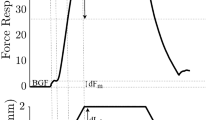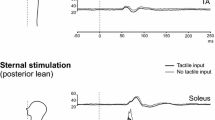Abstract.
Recent investigations have demonstrated that afferent signals from hindlimb flexor muscles can strongly influence flexor burst activity during walking and during fictive locomotion in decerebrate cats. We have reported previously that modifying afferent feedback from the sartorius (Sart) muscles by assisting or resisting hip flexion has a marked effect on the magnitude and duration of activity in iliopsoas (IP) as well as the sartorius muscles. The objective of the present investigation was to identify the afferents responsible for these effects by examining, in walking decerebrate cats, the influence of electrically stimulating sartorius afferents on burst activity in the IP and tibialis anterior (TA) muscles. Stimulation of the sartorius nerve at group I strength resulted in an increase in the duration of IP and TA bursts and an increase in the magnitude of IP bursts. The effect on burst durations was only observed at stimulus strengths of 1.6 T and higher. At lower stimulus strengths, there was a strong excitatory effect on IP bursts but no effect on TA bursts. Stimulation of the sartorius nerve at group II strength yielded variable results. When group II stimulation was delivered repeatedly during a walking sequence, the initial response was usually a strong inhibition of burst activity in IP and TA followed by a progressive reduction in inhibition and the emergence in IP of an excitatory response. This observation, together with findings of previous studies, suggests the existence of parallel excitatory and inhibitory pathways from sartorius group II afferents to flexor motoneurons. Taken together, these results support an earlier speculation that feedback from large afferents from the sartorius muscles has a strong influence on the generation of flexor burst activity in walking cats.
Similar content being viewed by others
Author information
Authors and Affiliations
Additional information
Electronic Publication
Rights and permissions
About this article
Cite this article
Lam, T., Pearson, K.G. Sartorius muscle afferents influence the amplitude and timing of flexor activity in walking decerebrate cats. Exp Brain Res 147, 175–185 (2002). https://doi.org/10.1007/s00221-002-1236-0
Received:
Accepted:
Issue Date:
DOI: https://doi.org/10.1007/s00221-002-1236-0




